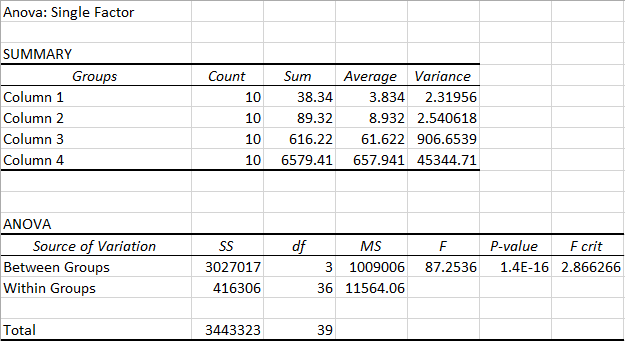BME100 s2015:Group5 9amL2
| Home People Lab Write-Up 1 | Lab Write-Up 2 | Lab Write-Up 3 Lab Write-Up 4 | Lab Write-Up 5 | Lab Write-Up 6 Course Logistics For Instructors Photos Wiki Editing Help | ||||||||||||||||||||||||||||||||||||||
OUR TEAM
LAB 2 WRITE-UPDescriptive StatisticsHumans
Rat
Results
AnalysisFor the human trials there were more than 2 groups, which called for the ANOVA test. Once the ANOVA test resulted in a p-value less than 0.05, as shown in table A, it was determined that there was a significant differentce betweent the groups. Now, in order to compare the 4 groups by pairs, t-tests were used for 6 different comparisons, as shown in table B. Because there is an error involved with multiple comparisons, the Bonferroni correction was used to adjust the p-value that the t-test values must be less than for there to be a significant difference. In this case, there were 6 total comparisons and so the normal p-value was divided by 6, (0.05/6), to get the value 8.33E-03. Each t-test value was less than 8.33E-03 and so there was a significance with each comparison, as shown in table B.
For the rat trials, since there wre only two groups and only one comparison, the t-test was a much more appropriate choice. As shown in table C, the two-tail p-value was not less than 0.05 and so there was no significant difference. It is possible that the drug, LPS, has little to no effect in rats compared to humans.
Summary/DiscussionThe human trials showed that there was a significant difference between the groups of different dosages. This information leads to the conclusion that the dosage of LPS has a direct effect on the amount of inflammotin, as the dosage goes up so does inflammation. However, that was not the case with the rats. Although there was a small increase in inflammotin with an increase in dosage, it was not enough to be considered significantly different. The rat trials could have lacked significant difference bacasue rats do not react to the drug in the same way that humans do. |
||||||||||||||||||||||||||||||||||||||







